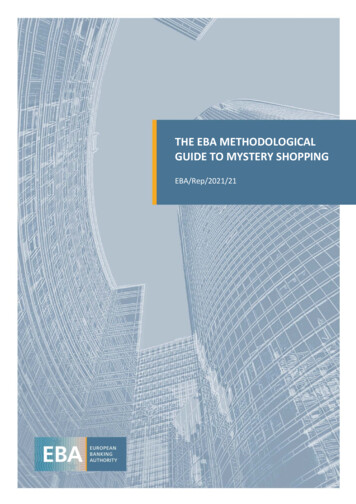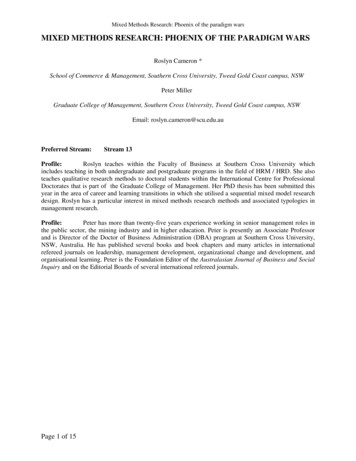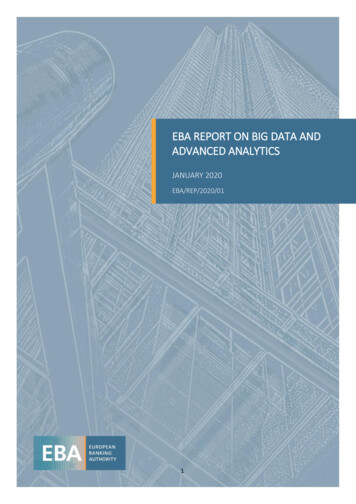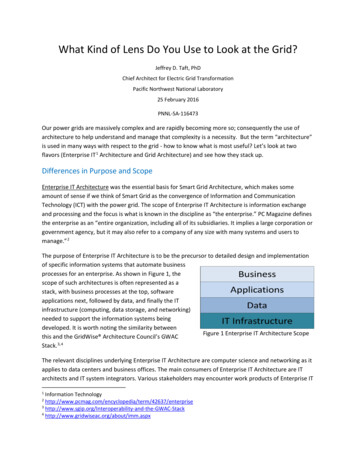
Transcription
THE EBA METHODOLOGICALGUIDE TO MYSTERY SHOPPINGEBA/Rep/2021/21
EBA METHODOLOGICAL GUIDE TO MYSTERY SHOPPINGContentsList of abbreviations3List of figures4Background and purpose of the guide5Key steps in designing and implementing a mystery shopping activity7STEP 1: Define the goals9STEP 2: Select products/services and distribution channels9STEP 3: Select financial institutions10STEP 4: Select mystery shoppers and consumer profiles11STEP 5: Design mystery shoppers’ scenarios12STEP 6: Design mystery shoppers’ assessment questionnaire and data gathering17STEP 7: Assess the findings and follow-up212
EBA METHODOLOGICAL GUIDE TO MYSTERY SHOPPINGList of abbreviationsEBAEuropean Banking AuthorityESAsEuropean supervisory authoritiesEUEuropean UnionFIFinancial institutionMSMystery shoppingNCAsNational Competent Authorities3
EBA METHODOLOGICAL GUIDE TO MYSTERY SHOPPINGList of figuresFigure 1: Key steps in designing and implementing a mystery shopping activity8Figure 2: Scenario briefing note specimen15Figure 3: Assessment questionnaire specimen194
EBA METHODOLOGICAL GUIDE TO MYSTERY SHOPPINGBackground and purpose of the guide1. Following the review of the three European Supervisory Authorities founding regulations 1, theEBA received a number of additional consumer protection mandates in Article 9(1) of itsFounding Regulation, which includes the mandate to ‘coordinate mystery shopping activities ofcompetent authorities, if applicable’. The mandate has been applicable since 1 January 2020.2. As a first step towards fulfilling this mandate, the EBA collated mystery shopping (MS) activitiesthat have been carried out by national competent authorities (NCAs). The activities weresummarised and assessed in a report 2 with a view to sharing experiences, learning valuablelessons, and identifying good practices for the benefit of the EBA and NCAs that use or intendto use MS in the future. The EBA report on MS activities of NCAs covers initiatives in respect ofproducts that fall within the scope of action of the EBA’s consumer protection mandate (i.e.mortgage credit, consumer credit, deposits, payment accounts, payment services andelectronic money). As mentioned in the EBA report, at this stage, only a limited number of NCAscarried out such MS activities in their jurisdiction. Moreover, some NCAs reported thatdiscussions are currently taking place at a national level regarding the possibility of adding suchpowers to their respective mandates, for some of them as part of the implementation of theConsumer Protection Cooperation Regulation 3.3. The EBA methodological guide to MS (hereafter ‘the guide’) has been developed based on thefindings and good practices identified in the EBA report on MS activities of NCAs and aims tosupport NCAs in the design and implementation of MS activities.4. The guide presents how MS activities can usually be conceived and carried out andrecommends how NCAs can use the guide as a complement to other existing supervisory tools,if needed. It sets out seven steps NCAs could usefully follow and adequately adapt to theparticular circumstances, goals and national possibilities when carrying out, either directly orby outsourcing to an external provider, MS activities for retail banking products and services.5. The guide applies to both on-line and on-site MS activities but voluntarily focuses on situationsrelating to on-site MS, based on the knowledge and experiences of NCAs to date. The growingreflections and experiences surrounding on-line MS will be reflected in the subsequent releasesof the guide.1For the EBA Regulation, see Regulation (EU) No 1093/2010.2EBA report on mystery shopping activities of NCAs EBA/REP/2021/08: published on 3 May ents/files/document y 1]3Regulation (EU) 2017/2394 on cooperation between national authorities responsible for the enforcement ofconsumer protection law.5
EBA METHODOLOGICAL GUIDE TO MYSTERY SHOPPING6. The guide is not mandatory and does not aim to harmonise the MS practices of NCAs or implythat all NCAs would need to adopt it as supervisory tool. Rather, the guide aims to supportthose NCAs that are, under their respective national legal framework, in a position to carry outMS activities in designing and implementing MS activities, thus facilitating the coordination ofNCAs’ MS activities and enhancing NCAs’ ability to assess the retail conduct of financialinstitutions (FIs) in their jurisdictions.7. For the purpose of the guide, ‘mystery shopping’ is understood as an undercover researchapproach used by NCAs, or by the market research companies that they may have hired, tomeasure the quality of customer service and/or gather information about financial productsand services and the conduct of FIs towards consumers. MS may include the use of individualswho may act as potential or actual customers and who are trained and briefed to experienceand measure key phases of a product’s lifecycle and compliance with particular requirements.They report back their experiences in a detailed and objective way. They perform specific tasks,for example reviewing how staff perform against pre-determined standards during aninteraction with a customer. That interaction may occur at the pre-contractual, contractual orpost-contractual phase and may involve purchasing a product/service, asking questions, orregistering complaints. MS enables supervisors to carry out an assessment, in concretesituations, rather than relying on documents kept by firms, on-site interviews, or surveys.8. MS activity is a useful component and a complementary tool to fulfil NCAs supervisory and/orsubsequent enforcement objectives, even if not every on-site supervision includes MS. SomeNCAs use MS when they deem it necessary and in cases in which they cannot otherwise provideevidence via on-site inspections. MS represents a useful tool to gather information aboutfinancial products and services and/or the conduct of FIs towards consumers. MS techniquesmay involve mystery observations, visits, telephone calls, mailing, e-mailing and website visits,but they are distinct from any on-site inspection tools used by NCAs in their jurisdictions. Forexample, MS gives NCAs the opportunity to collect information that cannot usually be obtainedby NCAs through their on-site inspections and allows them to assess the extent to which FIscomply with regulatory requirements, such as the disclosure of required pre-contractual and/orcontractual information to consumers.9. According to NCAs that conducted MS activities, MS represents a way to efficiently andeffectively monitor certain market practices, in particular for the pre-contractual phase as MSactivity allows, for example NCAs to check whether the required information was providedvoluntarily by the FI, or upon request by the mystery shopper, or not at all, etc. In manyjurisdictions, legal constraints (mandatory identification of the consumer, prohibition to signcontracts, personal financial records impacted, etc.) limit MS activities to the pre-contractualphase, which means that much of the content of this guide is primarily relevant to this precontractual phase.10. It should be noted that the above understanding of MS used for the purposes of the guide maydiffer from MS definitions or MS mandates used elsewhere.6
EBA METHODOLOGICAL GUIDE TO MYSTERY SHOPPINGKey steps in designing and implementinga mystery shopping activity11. The guide sets out seven steps that NCAs can take into account when building a MS activity: (1)define the goals of the MS activity; (2) select the products/services and their distributionchannels; (3) select the FIs to be mystery-shopped; (4) select the mystery shoppers andconsumer profiles; (5) design scenarios for mystery shoppers 4; (6) design the assessmentquestionnaire for mystery shoppers and data gathering; and (7) assess the findings and followup.12. Depending on the local context and applicable law, not every NCA may follow each of thesesteps with the same intensity and can adapt them according to their national needs. Thesesteps can either be conducted by NCA staff or outsourced to an external provider.13. Steps 4 to 6 concerning the selection of mystery shoppers, the design of the scenarios formystery shoppers, and the design of the assessment questionnaire and data gathering canpotentially be outsourced to an external provider if NCAs consider it useful. The eventualdecisions concerning core supervisory tasks, like the definition of the MS goal, selection of theproducts and services and the FIs subject to MS (steps 1 to 3), as well as the assessment of thefindings and the follow-up actions to MS activity (step 7) should, in principle rest with NCAs.The infographic below (figure 1) illustrates the various steps that can be followed, using twodistinct colours. The colour blue is used for the steps where ultimate decisions rest with NCAsas part of their core supervisory function, while grey is used for the steps that can beoutsourced to an external provider.4In some cases, e.g. in the case of outsourcing activities requiring very specific competencies, it might be useful to havethe scenarios for mystery shoppers already at hand when mystery shoppers are to be selected on the basis of thosescenarios.7
EBA METHODOLOGICAL GUIDE TO MYSTERY SHOPPINGFigure 1: Key steps in designing and implementing a mystery shopping activity8
EBA METHODOLOGICAL GUIDE TO MYSTERY SHOPPINGSTEP 1: Define the goals14. The most common conduct and consumer protection goals that could be feasibly pursuedthough MS activities include:-Assessing compliance with regulatory requirements: this includes NCAs evaluatingcompliance by the FIs with the regulatory requirements of banking products andservices, for example on the adequacy of information disclosure concerning theproduct/service, in particular pre-contractual information duties, selling practices, fairtreatment and an assessment of the suitability of a product or service for consumers’needs and profiles.-Evaluating whether the FI's staff have an adequate level of knowledge andcompetences: this includes NCAs assessing whether the relevant staff of FIs andappointed representatives possess and maintain an adequate and up-to date level ofknowledge and competence in relation to the manufacturing, offering, and/or sellingof particular products and services in order to achieve a high level of professionalism.MS also provides indications as to the extent to which sales staff have received trainingrelevant to the particular product/service. This also requires mystery shoppers to havethe skills to evaluate the knowledge and competence of FI’s staff. The MS assessmentquestionnaire provided to mystery shoppers can, for instance include a ranking toevaluate the skills of FI’s staff (see steps 4 and 6 for details).-Measuring compliance with and the effects of new regulatory changes: this could alsobe done through a MS exercise carried out before and then shortly after a regulatorychange has been implemented.15. The goals as well as other technical specifications of the MS activity, such as timescales or acalendar planning the duration of the MS activity, the team which will run the MS activity onsite or online, the approach, scope, and methodology used (scenario, length of assessment,frequency of visits/calls, etc.) and the topics or issues to be assessed, benefit from being definedearly in the process.STEP 2: Select products/services and distribution channels16. The EBA’s scope of action on consumer protection extends across a number of differentproducts and services, such as consumer credits, mortgage credits, payment accounts,payment services, electronic money and deposits. The channels through which these productsare sold and distributed, and which could therefore be the focus of an MS activity, also varyand include, for example, branches of financial institutions and intermediaries and, if needed,their websites, call centres and digital platforms etc.9
EBA METHODOLOGICAL GUIDE TO MYSTERY SHOPPING17. In order to define which conduct by FIs to assess, the products and/or services can be listedand then ranked based on risk criteria such as the existing gaps in supervisory knowledge,intelligence gathered from consumer complaints, the need to obtain evidence as to whether ornot existing requirements for specific products and services ought to be amended (e.g. in thecase of consumer complaints or issues identified on the market) and the emergence in themarket of new products/services, new actors, and/or new distribution channels.18. An in-depth assessment of the relevant regulations and legislative provisions applicable to theproducts and services would be necessary as well as an evaluation of the key characteristics ofthe products and services and associated information (e.g. fee information documents,statement of fees, European standard information sheet, standard European consumer creditinformation etc.).STEP 3: Select financial institutions19. MS activities can be designed to meet the specific needs of an NCA. The number of FIs thatcould be covered by a particular MS activity depends on the goal of the MS and the size of themarket and must be sufficient to draw grounded conclusions.20. In most cases, it is desirable for a MS activity to include as many different types of FIs and/ordistribution channels as possible that provide a particular product/service so as to fully capturethe diversity of the conduct of FIs in the market and to allow the conclusions of the MS activityto be robust. Different distribution channels (e.g. intermediaries, platforms) might have a majorimpact on consumer protection objectives, e.g. a product’s suitability or its price/costs.21. A MS activity benefits if the selection of FIs in terms of geography is reflective of the aim of theactivity. For example, a particular investigation into the conduct of FIs may benefit from ageographical scope that explicitly covers rural and/or urban areas; small and/or large branches;and/or only parts of the geographical area of the respective jurisdiction, whereas anotherinvestigation might not require any such differentiation (e.g. investigation of a single FI but atdifferent points of sale). To help ensure that a diverse range of FIs in a market is included in theMS activity, NCAs can select one or more restricted geographic location(s) that would matchthe MS objectives.22. The selection of FIs can also be based on other elements, for example on the results of acomprehensive risk-based analysis taking into account the relative importance of the FI and itsimpact on customers or complaints received by NCAs about FIs. This also means that aparticular MS activity can be carried out in respect of a specific FI to complement othersupervisory tools.10
EBA METHODOLOGICAL GUIDE TO MYSTERY SHOPPINGSTEP 4: Select mystery shoppers and consumer profiles23. As already mentioned, when carrying out MS, NCAs staff may either carry out MS directly ordecide to outsource it to an external provider, which would require hiring mystery shopperswho are not NCA staff.24. It is advisable to select mystery shoppers based on the goal of the MS activity defined by NCAsand to ensure that the personal characteristics and personal financial situations are alignedwith the NCAs’ goals and scenarios.25. In order to reduce mistakes, false results and/or unnecessary costs, specific requirements canbe defined to select mystery shoppers. The characteristics of the consumer profiles thatmystery shoppers should portray can be defined by NCAs according to the type of consumersthat are meant to be the subjects in the MS activity or that would fall within the target marketof the products and services designed by the FIs.26. Consumer profiles may vary from one MS activity to another and according to the products andservices and the distribution channels targeted. A consumer profile describes thecharacteristics of the individual that the mystery shopper will portray during the exercise, forexample in terms of the degree of financial literacy, degree of aversion to financial risk, gender,ethnicity, age and/or other characteristics relevant to effectively achieving the goal of the MSactivity. In certain situations where, for example, FIs may need to verify the credit historyinformation of consumers, certain features of a mystery shopper’s personal financial situationmay make certain mystery shoppers unsuitable for MS. There can also be circumstances inwhich certain types of consumers are identified by NCAs as being treated differently becauseof their recognisable affiliations or physical traits. In such situations, the selection of themystery shoppers can make use of additional criteria, if appropriate, such as race/ethnicity,gender, etc. with a view to detecting unfair treatments of consumers.27. The requirements for selecting the mystery shoppers will also depend on the approach andresources of the supervisory authority. Whether a MS activity is carried out directly by NCAs’staff or outsourced to an external provider, it is important when recruiting mystery shoppersto take into account to the extent feasible the personal background or characteristics thatmatch the consumer profile to be portrayed.28. For mystery shoppers to be able to fulfil the stated goal of the MS activity, they usually requiresoft skills such as observation, recording, reporting, team working, ability to play a role,memorise a script and interactions and create questions ‘on the go’ while interacting with FI’sstaff, as well as IT and in certain cases foreign languages skills, if applicable. Mystery shoppersshould also have sufficient skills to evaluate the knowledge and competence of F’Is staff whichshould also be acquired via the provision of training (see Step 5 for details). If they are selectedfrom among NCAs’ staff, a supervisory, consumer protection and/or inspection background canbe considered an asset. Legal, banking and financial competencies may also play a role in theselection of mystery shoppers.11
EBA METHODOLOGICAL GUIDE TO MYSTERY SHOPPING29. More specifically, for MS activity outsourced to an external provider, it is advisable to recruitmystery shoppers that are already familiar with the products and services and already havesome formal financial experience, in order for them to better embody their profiles, toeffectively report the information provided by the FI’s staff during the visit, and to fill-in the MSquestionnaire more reliably. Financially experienced mystery shoppers can also be instructedto ask several follow-up questions (to measure how well FIs’ sales staff explain certain productterms and features) that less experienced consumer may not ask.STEP 5: Design mystery shoppers’ scenarios30. One of the key steps towards a successful MS activity is to design an appropriate scenario anda scenario briefing note.31. For the purpose of this guide, ‘scenarios’ are the different situations in which mystery shopperscarry out their work and test the conduct of FI’s staff. For example, a scenario could instructmystery shoppers to ask several follow-up questions with the intention of measuring how wellFIs’ sales staff explain certain product terms and features or they could be explicitly instructedto let the FI’s sales staff lead the conversation and not ask any questions until the FI’s sale staffhave had time to provide this information voluntarily. In order to make the MS scenario morereliable, mystery shoppers may also be asked to adapt their dress code, for example to dressmore formally or dress casually depending of profile of the mystery shoppers need to portray.The training of selected mystery shoppers will help also in this regard. The scenario briefingnote would give the mystery shopper information about the background and rationale for eachscenario and focus on how to handle follow-up questions, thus providing convincing insights tothe role. A specimen for how such a scenario briefing note could be designed is provided infigure 2 below, which can be further adapted/expanded by NCAs to meet particular needs.32. The design of the appropriate scenario should usefully apply one or more of the followingcriteria:-Targeted: the scenario must be designed to test the specific sales, service oroperational behaviour targeted in the defined MS goal.-Credible: the scenario must be realistic in that it should replicate consumer behaviourin the market concerned based on the goal set by the NCA and can be providedconvincingly by the mystery shopper. However, while mystery shoppers must bethoroughly briefed, the findings will need to be collected by the mystery shopper underreal circumstances like those experienced by usual or potential customers, whichmeans that FI’s sales staff cannot guess from the mystery shopper’s behaviour andattitudes that he/she is not a real customer. Otherwise this could compromise thevalue of the MS exercise.12
EBA METHODOLOGICAL GUIDE TO MYSTERY SHOPPING-Straightforward, simple and brief: the scenario itself can be simple andstraightforward, so the mystery shopper can easily understand and apply it. Ideally, ascenario briefing note should be more detailed. The simplicity, brevity, andappropriateness of the assignment ensures that experiences are correctly reported.-Ethical: mystery shoppers must not be asked to do anything that exposes them to anykind of risk (e.g. locality, disability, gender or ethnicity) or puts them in situations whichcould be in conflict with existing national law (e.g. more specifically, mystery shoppershired in the context of a MS outsourced activity must not encourage any FIs to commitinfractions or mis-behave, and they must not record the MS activity if this is not allowedby law). Mystery shoppers shall act as customers or potential customer during a normalbanking transaction. They shall assume a neutral rather than an aggressive or defensiveapproach when exercising their tasks. Consequently, they should not provoke or trickthe FI’s staff into making a mistake. When obtaining information, the mystery shoppersshould not be unduly intrusive and should not do anything out of the ordinary. Rather,they should act like an average consumer and ask what ‘anyone’ with the chosenconsumer profile would be in a position to ask. Given the specificity of banking productsand services it is of particular importance to prevent any adverse implications ofcarrying out an evaluation (e.g. personal safety, effect on credit references).33. Given the consumer profile that mystery shoppers may portray, it is important that the selectedmystery shoppers have a deep knowledge and/or receive adequate training on MSmethodologies and banking product and services, but also regarding the specific situation andcontext of the FI where the MS activity will take place. This training on MS methodologies couldentail an outsourced, recorded video session.34. Training and briefing materials serve to train the mystery shoppers on how the interactionshould play out. This is critical to ensure consistency, quality, and the overall success of the MSactivity, no matter the size or scale. Deploying video training and briefing materials via short,engaging multimedia clips could be seen as an effective way for mystery shoppers tounderstand better the scenario and adapt to various situations.35. As part of the training, pilot phases could also be planned for mystery shoppers to test thescenario and to ensure that it makes sense in a real-life situation as well as to check that briefingnotes and assessment questionnaires - which should be designed at the same time as the MSscenario is defined (see step 6 for details) - adequately cover all the issues to be reported bythe mystery shopper. Because, the mystery shoppers can use their own personal experiencesduring the activity, in order for them to make their story consistent and limit as much aspossible the amount of specific information they have to remember, the pilot phase will alsoallow for fine-tuning of the scenario, if necessary. Reference by the mystery shopper to his/herpersonal experience should however always remain part of the final agreed scenario in orderto prevent any procedural mistakes.13
EBA METHODOLOGICAL GUIDE TO MYSTERY SHOPPING36. Additional elements can be considered with a view to designing and implementing a successfulscenario and in order to ensure that the MS activity is useful for the NCAs. These additionalelements include the following:-The scenario should produce a reliable picture of the FI’s conduct. This means thatthere cannot be a warning or other announcement from the mystery shopper or fromthe NCA regarding the location or timing of the MS activity;-Ideally, MS activity can be conducted multiple times by mystery shoppers over a periodof time and at different working hours, different times of the day and/or week, toensure coverage of different environments in which the conduct is assessed. This willreduce the effect of special situations and will also provide a way of measuring theeffects of improvement that have been made after the results obtained on the mysteryshopper’s first visit;-If MS is performed by the NCA or outsourced to an external provider, it is good to planfor the MS activity to be performed in teams of at least two people, with oneexperienced member of staff;-The scenario and the briefing note may include words to use and to avoid;-The frequency of assessment could also be considered. This may depend on the lengthof the assessment which needs to be carried-out. The length of visit may vary anddepend on the nature of a product or service, on the consumer’s needs and on thecontractual phase to be examined (pre-contractual, contractual or post-contractualstage). In any case, the mystery shopper should not take up any more time than anormal customer.14
EBA METHODOLOGICAL GUIDE TO MYSTERY SHOPPINGFigure 2: Scenario briefing note specimenSCENARIO BRIEFING NOTECONSUMER PROFILE Low knowledge High knowledgePROFILE:Low degree of knowledge, uses banking services at a basic level. has higher education, but doesnot have specific knowledge about financial characteristics of banking productsEXPRESSIONS:-Should use expressions such as ‘loans to buy a house’, ‘how much it costs’, ‘I want to know theconditions’, ‘How much will I pay per month?’;-do not use technical terms like ‘mortgage credit’, ‘commissions’, ‘effective interest rate (APR)’SCENARIO:-Wants to buy a house at a cost of 190,000 euros. Asks for loan of 150,000 euros (80% LTV).Term of 30 years-You are employed. You have an annual income of 25,000 euros. You do not want to provideyour ID/fiscal number (unless absolutely necessary)INITIAL APPROACH:-Start the process: you want to know the conditions for a loan to buy a house. Say that you arerequesting proposals from different banks, having already started with the bank with whom youwork.DURING THE MYSTERY SHOPPING INSPECTION:-Let the employee present and explain the product-Analyse the documentation that is provided by the employee. After the employee provides thestandardised information sheet (SIS), if he/she does not explain it, ask ‘What do I have to read?’or ‘What is important?’-Explore and confront the employee with various issues if he/she does not refer to them on theirown initiative. If the employee mentions the Annual Percentage Rate (APR), ask him/her toexplain what it is. If the APR is not mentioned, try to introduce this question in the course of theexplanation after the employee has talked about the costs of the loan. For example, based onSIS asking: ‘What does this [APR] mean?’ Or mention that you see the APR in advertising and donot know the meaning.END OF THE MYSTERY INSPECTION:Request the employee’s contact card.15
EBA METHODOLOGICAL GUIDE TO MYSTERY SHOPPINGQUESTIONSQuestions 1:[initial approach] I want to apply for a loan to buy a house. What are your terms?Goal: assess delivery of SIS and employee’s initial explanationBrowse: Standardised Information Sheet (SIS)Question 2:[After the employee hands over the SIS, if the employee does not explain properly, ask:]What do I have to read? or What is important?[If necessary, ask specifically] What is the APR? [see APR with sales of other products andwithout sales, if applicable][If necessary] What fees will I pay on the loan?[If necessary, in the case of variable rate loans] Questions about the scenarios of ratevariations/instalment amount/repayment plansGoal: assess whether the employee mentions/explains the APR, fees, rates variation scenariosand the main financial characteristic of the loanQuestion 3:Do I have to take out life insurance contract with you? Can I purchase this insurance fromsomeone I know who sells insurance products, who may have better conditions?[If necessary, state that you do not want any products. If the set of products includes, forexample, a credit card, say that you do not want it. Assess whether the institution presents theSIS without sales] I do not want any other products. What are the conditions?Goal: assess if there is tyingBrowse: SIS and check information about other products, whether they are mandatory or not16
EBA METHODOLOGICAL GUIDE TO MYSTERY SHOPPINGSTEP 6: Design mystery shoppers’ assessment questionnaire anddata gathering37. In parallel to the design of the MS scenarios and scenario briefing materials, an assessmentquestionnaire for mystery shoppers can be prepared. The assessment questionnaire, whichcould involve a checklist, represents a set of questions the mystery shopper will answer afterinteracting with the FI. This assessment questionnaire would aim to help the mystery shopperto gather the necessary information in a precise way during the MS activity in order to reportback to the
a mystery shopping activity . 11. The guide sets out seven steps that NCAs can take into acco unt when bu ilding a MS activity: ( 1) define the goals of the MS activity; (2) select the products/services and their distribution channels; (3) selectthe FIs to be mystery -shop










